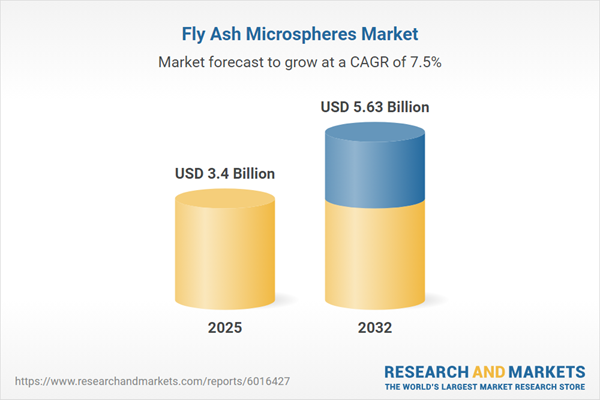Speak directly to the analyst to clarify any post sales queries you may have.
Fly ash microspheres are redefining advanced material innovation in industrial and environmental applications, offering sustainability, performance, and reliable supply for organizations seeking durable, lightweight, and efficient material solutions.
Market Snapshot: Fly Ash Microspheres Market Growth and Outlook
The fly ash microspheres market grew from USD 3.16 billion in 2024 to USD 3.40 billion in 2025. With a projected CAGR of 7.48%, the market is on track to reach USD 5.63 billion by 2032. Consistent growth arises from increased demand across construction, ceramics, coatings, and energy sectors, supported by ongoing technological advancement and sustainability initiatives.
Scope & Segmentation
- Raw Material Type: Class C, Class F
- Application: Ceramics (Porcelain, Technical Ceramics), Coatings (Architectural, Industrial), Oil Well Drilling (Cement Additive, Drilling Mud Additive), Polymer Fillers (Thermoplastics, Thermosets)
- Form: Dry, Paste, Slurry
- Purity Grade: High Purity, Standard, Technical
- Particle Size: 10–45 Micrometers, Above 45 Micrometers, Under 10 Micrometers
- Distribution Channel: Direct Sales, Distributors, OEMs, Online Sales
- Geographical Coverage: Americas (United States, Canada, Mexico, Brazil, Argentina, Chile, Colombia, Peru), Europe, Middle East & Africa (nations across Europe, Middle East, Africa), Asia-Pacific (China, India, Japan, Australia, South Korea, Indonesia, Thailand, Malaysia, Singapore, Taiwan)
- Leading Companies: 3M Company, J.M. Huber Corporation, Guangzhou Minelco Micromaterials Co., Ltd., Changsha Sinoma Joinchem Co., Ltd., Cosmo Specialty Fibres (India) Limited, Pergan GmbH, Henan Keyin Powder Metallurgical Co., Ltd., Micronised Minerals Limited, FlyCen, Inc., C-Sphere Limited
Key Takeaways
- Technological innovations—especially automated spray drying and real-time monitoring—are raising product precision and efficiency, delivering consistent material performance that appeals to high-precision industries.
- Sustainability drivers and stringent emission standards are increasing the demand for fly ash microspheres as low-carbon alternatives, aligning with global circular economy objectives.
- Material segmentation by class, purity, and particle size is crucial for meeting performance standards in demanding fields such as aerospace, electronics, construction, and oil well operations.
- High-purity and specialized forms facilitate applications in advanced ceramics, coatings with improved environmental properties, and polymer composites with enhanced strength-to-weight ratios.
- Geographic growth is led by infrastructure investment in the Americas and Asia-Pacific, while strict environmental policies in Europe, Middle East & Africa support the utilization of industrial by-products.
- Collaborations between material scientists, manufacturers, and end users are rapidly advancing bespoke product development and expanding innovative application domains.
Assessing the Impact of U.S. Tariff Policies
Recent U.S. tariff policies have prompted industry participants to reevaluate sourcing and supply chain strategies. These changes are increasing interest in diversified supplier relationships, domestic processing investments, and collaborative ventures that span coal power production and microsphere manufacturing. Stakeholders are renegotiating contracts and shifting logistics to balance cost with supply resilience.
Methodology & Data Sources
This market study uses a multi-tiered research design, combining a comprehensive review of technical and regulatory materials, qualitative interviews with industry experts, and in-depth surveys with value chain participants. Findings are validated by cross-referencing data from consortiums and utilizing advanced analytical platforms with robust qualitative and quantitative techniques.
Why This Report Matters
- Enables senior decision-makers to benchmark against regional and global industry leaders by understanding competitive strategies and market dynamics.
- Delivers actionable insight into segment-specific opportunities and evolving regulatory conditions critical for strategic investment and innovation planning.
- Guides operational and procurement teams on navigating supply chain complexity, technological advancements, and sustainability imperatives.
Conclusion
Fly ash microspheres are transforming the landscape of high-performance materials through a combination of sustainability, technology enhancements, and strategic partnerships. This research empowers organizations to anticipate market shifts, optimize applications, and advance sustainability objectives in a dynamic sector.
Additional Product Information:
- Purchase of this report includes 1 year online access with quarterly updates.
- This report can be updated on request. Please contact our Customer Experience team using the Ask a Question widget on our website.
Table of Contents
3. Executive Summary
4. Market Overview
7. Cumulative Impact of Artificial Intelligence 2025
Companies Mentioned
The companies profiled in this Fly Ash Microspheres market report include:- 3M Company
- J.M. Huber Corporation
- Guangzhou Minelco Micromaterials Co., Ltd.
- Changsha Sinoma Joinchem Co., Ltd.
- Cosmo Specialty Fibres (India) Limited
- Pergan GmbH
- Henan Keyin Powder Metallurgical Co., Ltd.
- Micronised Minerals Limited
- FlyCen, Inc.
- C-Sphere Limited
Table Information
| Report Attribute | Details |
|---|---|
| No. of Pages | 192 |
| Published | November 2025 |
| Forecast Period | 2025 - 2032 |
| Estimated Market Value ( USD | $ 3.4 Billion |
| Forecasted Market Value ( USD | $ 5.63 Billion |
| Compound Annual Growth Rate | 7.4% |
| Regions Covered | Global |
| No. of Companies Mentioned | 11 |









